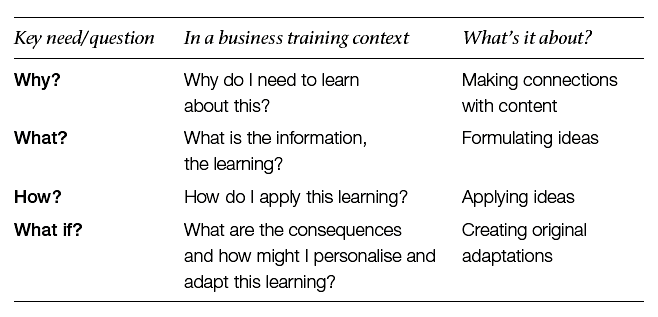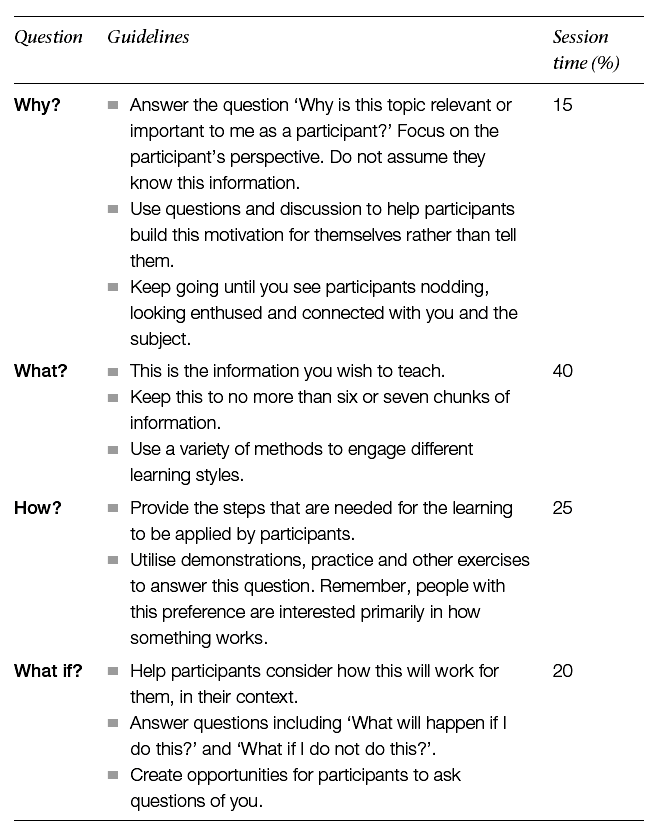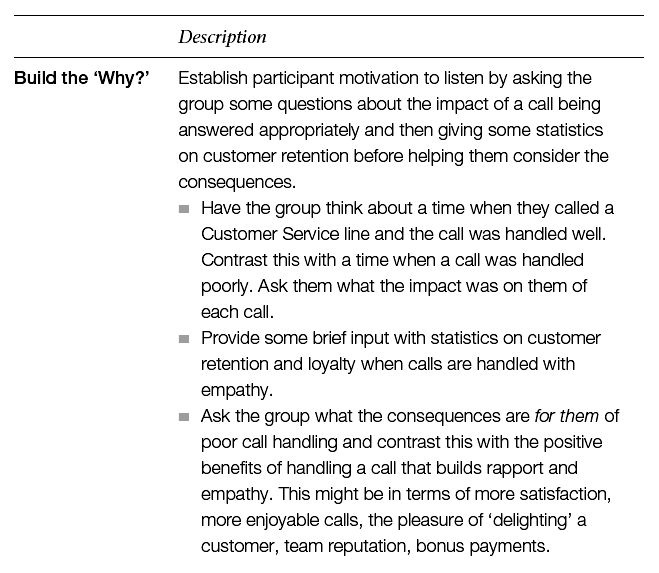How to structure your training
Imagine that you are about to take a trip somewhere new. It will involve a car journey of some hours across areas that are unknown to you. You have no idea what to expect or whether you will encounter any problems on the way. What would you need to give you more comfort in advance of the journey?
Few of us would set off without some kind of map or SatNav device. The map would show our destination and give us key points on the way that would help us know we were on the right track. With a clear view of the route we are to take, the main towns we are to pass through and having checked that this is all realistically possible in the time we have allowed, we can look forward to and enjoy the journey itself.
Your business training is no different. Your participants need to know where they are heading and how you are going to help them get there. They need to see that it is logical and realistic.
Structure refers to the relationship or organisation of the component parts of the training. It enables you and your participants to have a clear understanding of how the training has been put together to achieve the learning outcomes.
A good structure brings a number of benefits for you as trainer:
- You can break the training into manageable chunks, making it easier to design and deliver.
- You can engage participants more by showing them that the learning is a logical progression.
- Structure is an aid to planning your time for the training session.
- They have a route map for the training – they know what is coming so they can enjoy the journey – some people just like the ‘safety’ of having a structure.
- A structure sets expectations so participants can focus on their learning.
- It can provide a theme or metaphor to engage participants.
So, what is the right structure? There is an old saying in presenting circles:
Tell them what you’re going to tell them,
Tell them,
Tell them what you’ve told them.
There is a lot of good sense in this.
Your training needs to be structured to incorporate elements of:
- outlining your agenda and key messages up front;
- the content itself – the information and practice to support the key messages;
- a summary of what you have covered including the key messages again.
While the ‘tell them what you’re going to tell them, tell them, tell them what you’ve told them’ approach is still useful at a high level, it will not answer your needs for structure in any but the simplest of training sessions. You need some clear guidelines to ensure you engage all participants on any learning journey that you design.
How to structure your training to maximise engagement
Why is it that some trainers can engage a whole audience right from the start of a session and maintain that engagement throughout the training? What do you need to focus on in order to ensure this happens all the time?
In our analysis of good trainers we found that the approaches they use (often unconsciously) to address these questions are rooted in the structure of their programmes.
Their structure has two distinct features:
- engaging all participants from the start, and
- maintaining engagement for the duration of the training.
Here is how you do it.
Engaging all participants from the start
Over 30 years ago, Dr Bernice McCarthy synthesised research into student learning in US schools into a new style of teaching called the 4MAT® system. This system provides a key structural success factor that should be built into your training design.
What McCarthy discovered was that some school teachers were able to engage all students immediately a class started whereas other teachers could not.
The research found that different students needed different information in order to engage with the topic. If a teacher was to engage everyone from the start there was a correct order in which to cover these needs:
- Some wanted reasons for the learning – the why?
- Others wanted the facts and information – the what?
- Others wanted to know how things would work in practice – the how?
- The remainder wanted to explore future consequences – the what if?
The 4MAT (see Figure 9.1) system has been tested against other systems for school learning and consistently outperforms them in various aspects of learning performance.

Figure 9.1 The 4MAT system
Source: Adapted from Bernice McCarthy (2000) About Learning, www.aboutlearning.com
The 4MAT system explains learning in terms of the ways people perceive and process information. One aspect of its use is providing a road map to cover material in a business training workshop so as to maximise participant engagement and learning.
Like learning styles, preferences as to how information is covered remain largely unconscious in individuals but have an important impact on their attention. Each of the four preferences identified related to a key question in the mind of the learner that they needed to have answered. Whilst the research was based in the schools education system, we have found it highly effective within business training.
The 4MAT system describes four different needs that a learner may have in perceiving and processing information. The four needs should be addressed in a specific order to engage all participants. The key needs take the form of questions that have to be answered. The order in which these questions should be covered by your business training are as follows:

While all learners need to have answers to all questions, they approach learning through the lens of their preference – they pay attention to one question more than the others. This means that we need to cover all four bases in our training. If you have participants in your training who have a preference for needing the ‘Why?’ answered and they are not given this, it is likely that they will not pay full attention to the other aspects of your training.
What does this mean for your training design and delivery? Design your training to cover each of the four questions in order. Apply the 4MAT system to each separate topic within your training so that the ‘Why, What, How and What if’ are covered for each topic.
In the table below we suggest a percentage of time you should spend on each question. This can only be approximate but we find that most trainers do not spend enough time on the initial step of building the ‘Why?’ so pay particular attention to this aspect.
After explaining a little of the ‘What?’ to outline the subject or topic of your training, focus on the following:

The 4MAT system provides a high-level structure for your training. It ensures that you will engage all of your learners and address their specific needs.
For more information about Dr Bernice McCarthy and the 4MAT system follow the link on our website: www.ftguidetobusinesstraining.com.
Building the ‘Why?’
Building the ‘Why?’ is not simply the first part of the 4MAT system. It has much greater value and you need to pay particular attention to this element at the start of any business training. We have seen many training sessions that go straight into the ‘What?’ and do not get the learners motivated to learn. We attended a workshop where the trainer came in with a big book of materials, dropped it on the table from a great height with a huge thud and his first words were ‘We have a lot to cover over the next two days, let’s get started.’ He proceeded to dive straight into content that he was really enthusiastic about while we were still trying to recall why this topic was so important to us.
You have to ensure your participants are motivated to listen before you proceed with giving them content. Just because they are attending the training it does not mean they are thinking about the topic or how it will be of value to them. You need to build a compelling ‘What’s in it for me?’ from their perspective to engage them and motivate them to listen. This is covered in more detail in Chapter 11.
At the start of your training, ensure you allow enough time to build the ‘Why?’ Do this through planning questions that will raise participant awareness. This is far more effective than simply telling them why the topic is important, because it builds awareness.
Maintaining engagement for the duration of the training
Within the 4MAT structure you need to pay attention to the amount of information you give to participants and structure it in a way so information is retained. Often you need to deliver large amounts of information. Knowing how to do this effectively will make a big difference to your training effectiveness.
In 1956, George A. Miller published a paper ‘The Magical Number Seven, Plus or Minus Two: Some limits on our capacity for processing information’. Miller found that our short-term memory has limited ‘slots’ available to receive and store information. As the title of his paper suggests, the number is 7±2, so between 5 and 9 slots. When information is grouped together into chunks that fall within this 7±2 number we find it easier to recall it. Think of telephone numbers. A single string of 11 numbers in the UK is generally grouped into a chunk of five (the code) and six. In France, the eight-digit telephone number is typically shown as four pairs of numbers.
Use this number arrangement to maximise the chance of retention. Ensure that you limit the amount of content ideally to between five and seven items: this is well within the 7±2 number. When you need to convey more information group items together, or nest them, so as to maintain a structure that fits within our recommended five to seven items.
The following example illustrates the concept:
Example
Let’s assume we are developing a presentation skills training and we have identified the following content elements that must be included:
- Body language
- Breathing
- Establishing credibility
- Creating rapport
- Building the ‘Why?’ for our audience
- Organising our content
- Creating a strong opening
- Creating a strong close
- Use of signposting
- How to handle questions
- Motivating for action
- Using creative visual aids
- Flipchart techniques
- PowerPoint tips
If we apply the 7±2 rule, the agenda is:
- The start
- Breathing
- Body language
- Establishing credibility
- Creating rapport
- Breathing
- Structuring your presentation
- Building the ‘Why?’ for your audience
- Creating a strong opening
- Creating a strong close
- Organising your content
- Use of signposting
- Building the ‘Why?’ for your audience
- Visual aids
- PowerPoint tips
- Using creative visual aids
- Flipchart techniques
- PowerPoint tips
- Closing your presentation
- Motivating for action
- Handling questions
- Motivating for action
By grouping the items in this way, we show that there are four key elements that will be covered and no more than five items in each of these. This makes it easier for participants to relate to the content both during the training and afterwards.
Using themes and signposts
To engage participants fully, your training must have some logic or theme that explains the journey. This will depend on your training subject but some examples are:
- teaching a new process: use the chronology of the steps as the structure;
- developing sales excellence: a martial arts theme – your inner resources, being prepared, taking the right action;
- new employee induction: the company (background, structure), you as an individual (your role, expectations), the small print (contract terms, processes).
This use of a theme or an underlying logic provides a map for participants that is easily understandable. It will orientate participants to the training and how the content will be covered. You should refer to this map during the course of the training to recap what has been done, explain where you are in the workshop and indicate what is to come.
Both the 4MAT system and the 7±2 rule can be used within the overall theme or logic of your training structure.
Structuring a session to retain audience attention
In Chapter 12, we state that the average attention span of an audience is between 10 and 20 minutes. When structuring and delivering your training, take account of this.
You should bring enough variety to retain engagement for the duration of the session. How can this be woven into the structure?
The following table shows how this might be done. It relates to one element of customer service training where the session objective is to have participants answer calls in a way that builds rapport and demonstrates empathy.

In this example, we have broken the session into six discrete elements and used different training methods to establish motivation, raise awareness, deliver information and then embed the learning.
This example also shows the use of the 4MAT system: establishing the ‘Why?’ first, then considering the ‘What?’ (raising awareness about the key issues and providing the input) before moving to the ‘How?’ (demonstrating and practising) before finally covering the ‘What if?’ (through reflection, discussion and questions).
How to motivate your audience
When was the last time you walked into a room and soon got a strong sense that many of the participants would rather be elsewhere? It has happened to most trainers at some point. We were recently delivering a programme on ‘Mastering difficult conversations’ and the motivation of our participant groups was typically between 3 and 6 on a scale of 1–10 where 10 was ‘highly motivated to attend’.
Not all of the groups you train will be highly motivated and ready to learn and apply everything you want to teach them. You will be faced with groups that will be somewhere from enthusiastic through agnostic to negative and not wanting to be there.
For your training to succeed with groups who are less than positively engaged, you must take action. You are likely to have an idea of participants’ levels of engagement and motivation with the topic as you embark on a needs analysis so your structure can be informed by this.
Considering the audience’s motivation and state of mind is important. You will not bring about behaviour change, skills or knowledge transfer, or fulfil any other useful training outcomes, if the group are not motivated to listen and engage. A lot of trainers do, however, plough on with delivering their content even when they know the audience members are not keen to listen to it. They might even be enthusiastic about the content themselves and feel that this will somehow transfer to the group through osmosis.
There is a simple process that will help you structure training that is much more likely to be listened to and engaged with:
- Consider your learning outcomes for the training and how you want participants to feel at the end of the training.
- What are your learning outcomes? What do you want participants to be able to do, understand or commit to?
- What do participants need to feel in order to be most likely to achieve the learning outcomes and apply the learning? This might be ‘motivated’, ‘confident’ or some other state of mind.
- Consider the motivation and feelings of the participants at the start of the session.
- Be as realistic as possible. What might your participants be feeling at the start of the training? This might be ‘anxious’, ‘de-motivated’, ‘frustrated’, ‘agnostic’ or something else.
- Acknowledge any gap that exists and objectively consider if this gap can be realistically closed during the training.
- What is the gap in how people feel and how you want them to feel?
- Is it realistic to close this gap during the course of the training (taking account of content and duration of training)?
- Plan the stages to move the group from how they may feel at the start of the training to how you want them to feel at the end.
- Consider how they feel at the start of the training. What is a small step towards how you want them to feel at the end of the training that would be realistic?
For example, if they enter the training feeling ‘disinterested’ and we need them to be ‘motivated’ to take action at the end, the gap is too big to close in one step. It will be of no benefit to teach them content while they are disinterested and we cannot immediately move them to ‘motivated’. We need to move them first from ‘disinterested’ to ‘open to listen’. This would represent a move toward ‘motivated’.
Plan the first part of your session to achieve this step. In our example, you could give them some facts that surprise them or ask them some questions that put their awareness on the ultimate consequences of staying as they are. - Once you have achieved this first step, what is the next step towards the way you want them to feel at the end of the training?
In our example, once they are ‘open to listen’ we can move them to ‘curious’. You can employ different methods to achieve this. You might set up a group exercise to look at benefits of change to different stakeholders, implications of change to them and the business and so on. Once the group is ‘curious’ you could then seek to move them to ‘engaged’ and on through other steps until you have them ‘motivated’.
- Consider how they feel at the start of the training. What is a small step towards how you want them to feel at the end of the training that would be realistic?
Structuring your training to move people through different states and feelings acknowledges that a group must want to learn if your training is to be effective. Delivering content to a group who are not interested in learning is a waste of both time and money. Plan to move your participants in specific manageable steps towards a state of mind that is commensurate with achieving your learning outcomes.
All of the concepts in this section work together and should be integrated in your design.
Summary
The structure of your training must take account of a number of elements to ensure success:
- Use the 4MAT system to ensure you appeal to all learners. Start with building the ‘Why?’ before giving the ‘What?’, then the ‘How?’ and finally the ‘What if?’.
- Spend enough time and thought on building a compelling motivation for participants to engage with your topic. Create a strong ‘What’s in it for me?’ before you deliver any content.
- Limit the amount of content you deliver to between five and seven key elements or points that you want participants to understand. If you must convey more information than this, group the information so that no one session has more than 5–7 elements in it.
- Ensure you have a theme or logic to how your training is structured.
- Build in variety by using different training methods to ensure you retain audience engagement.
- Consider your audience’s motivation to engage with the training and plan how you will move them towards a state commensurate with achieving your learning objectives.


